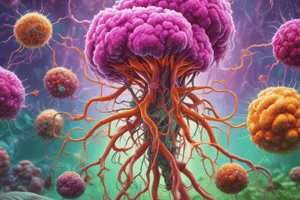Podcast
Questions and Answers
Which of the following accurately describes how lymph is formed in the lymphatic system?
Which of the following accurately describes how lymph is formed in the lymphatic system?
- Lymph is formed from interstitial fluid entering lymphatic capillaries due to their unique structure. (correct)
- Lymph is formed from lymphatic capillaries absorbing plasma and sugars.
- Lymph is formed from the diffusion of nutrients across tissues into lymphatic vessels.
- Lymph is formed from interstitial fluid accumulating in blood vessels.
What is the primary function of lymph nodes within the lymphatic system?
What is the primary function of lymph nodes within the lymphatic system?
- To store lymph and prevent its movement.
- To absorb nutrients from lymph before it enters the bloodstream.
- To produce lymph and distribute it to blood vessels.
- To filter lymph and facilitate immune responses. (correct)
Which statement about the lymphatic vessels is correct?
Which statement about the lymphatic vessels is correct?
- Lymphatic vessels are responsible for moving blood through the heart.
- Lymphatic vessels do not contain any muscles for movement.
- Lymphatic vessels have a one-way flow due to valves and milking actions. (correct)
- Lymphatic vessels rely solely on the contraction of smooth muscles to transport lymph.
What distinguishes follicular lymphoid tissue from diffuse lymphoid tissue?
What distinguishes follicular lymphoid tissue from diffuse lymphoid tissue?
How do the thoracic duct and right lymphatic duct differ in their role within the lymphatic system?
How do the thoracic duct and right lymphatic duct differ in their role within the lymphatic system?
Flashcards
Lymphatic Vessels Direction
Lymphatic Vessels Direction
Lymphatic fluid (lymph) flows from capillaries to vessels to trunks and finally to ducts (thoracic and right lymphatic).
Lymph Formation
Lymph Formation
Lymph is formed from interstitial fluid entering lymphatic capillaries, a process aided by unique lymphatic capillary structure.
Lymph Node Function
Lymph Node Function
Lymph nodes filter lymph, play a role in immune response, and contain various immune cells.
Lymphatic System Components
Lymphatic System Components
Signup and view all the flashcards
Lymph Node Structure
Lymph Node Structure
Signup and view all the flashcards
Study Notes
Lymphatic System Overview
- The lymphatic system serves the immune, cardiovascular, and digestive systems.
- Lymph (plasma plus proteins) moves through capillaries, vessels, trunks (five), and ducts (two: thoracic and right lymphatic).
Lymphatic Vessel Structure and Function
- Lymph flows from capillaries, through vessels, then to trunks, and finally into the two main ducts.
- Lymph movement is facilitated by the one-way structure of the capillaries, along with the milking action of veins, muscle movement, and breathing.
Lymph Formation and Capillary Structure
- Lymph is formed from interstitial fluid.
- Lymphatic capillaries have unique structures (e.g., overlapping endothelial cells) that promote fluid entry.
Lymphoid Tissue Structure and Types
- Lymphoid tissue contains reticular cells and white blood cells (WBCs).
- Lymphoid tissues include diffuse and follicular types found in various locations.
Lymph Node Structure and Function
- Lymph nodes are located throughout the body.
- Lymph nodes have a specific histological structure.
- Lymph flows through lymph nodes from afferent vessels to efferent vessels.
- Having more afferent (incoming) than efferent (outgoing) vessels helps filter and process lymph.
Lymphoid Organs
- Primary lymphoid organs: Thymus and bone marrow.
- Secondary lymphoid organs: Spleen, lymph nodes, and mucosa-associated lymphoid tissue (MALT).
Studying That Suits You
Use AI to generate personalized quizzes and flashcards to suit your learning preferences.
Description
This quiz covers the key aspects of the lymphatic system, including its role in the immune, cardiovascular, and digestive systems. It also examines the structure and function of lymphatic vessels, lymph formation, lymphoid tissues, and lymph nodes. Test your knowledge on how these components work together to maintain bodily functions.




